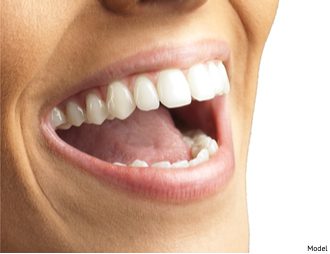Dental Implant or Bridge? Which Is Better for Me?
3 Min Read:
If you have lost a tooth due to decay, gum disease, or accident, you have several options for replacement, including a dental implant or bridge. Determining the right tooth replacement option can be tricky, but understanding the differences between these two options can help steer you to the healthiest choice.

What Is the Difference Between an Implant and a Bridge?
A dental implant is a permanent replacement for a missing tooth. This option surgically implants a titanium “root” into the jawbone, and a custom-created ceramic tooth is installed on the implant that fits snugly between the surrounding teeth.
Implants are made in two parts: the “root” and the restoration (crown). This multi-step procedure is performed over a series of months; however, temporary crowns can be installed so that no one will notice the process occurring in your jawbone.
The actual implant is a titanium root that fuses with the jaw bone beneath the gum. Once the titanium root is placed and connected firmly to the bone, the ceramic crown is screwed on top. Implants are designed to be permanent.
A bridge is also a permanent tooth replacement option, but it requires drilling of the adjacent teeth to the missing tooth. This option can result in issues and compromise the adjacent teeth.
Is an Implant Better for Your Adjacent Teeth and Jaw?
When you lose a tooth, the jaw bone can atrophy, meaning it deteriorates. The roots of the teeth stimulate the jawbone and keep it intact and healthy. Once the tooth is lost, the jawbone is not stimulated and the bone will start to atrophy. Also, the missing tooth can result in the adjacent and opposing teeth to move and create problems with occlusion (bite) and make future treatments more complex and expensive.
A bridge does not insert anything into the jawbone therefore it cannot stimulate the bone. Over time, it will allow the jawbone to deteriorate. Additionally, the adjacent teeth that hold the bridge in place must be shaved (drilled) down for the bridge to fit. Essentially, you are compromising the longevity of the adjacent teeth, instead of only focusing on the one that was lost—making a one tooth problem into a three teeth problem.
Do Dental Implants or Bridges Look Better?
Properly made, implants can be virtually indistinguishable from your natural teeth. The crown is created to be on the same level and shape as the rest of your teeth, and the ceramic crown can even be tinted/stained to match the existing teeth. You can smile with confidence day and night with a fully functional new tooth.
While dental bridges look good, in most instances good adjacent teeth are compromised. Since the teeth have to be connected to each other it makes oral hygiene, such as flossing, almost impossible which will result in increased risk of tooth decay and periodontal (gum) disease.
Are Dental Implants or Bridges Easier to Care For?
Caring for a dental implant is the same as caring for your natural teeth. You can use the same toothpaste and mouthwash that you are used to and rely on the same brushing and flossing techniques that you always have.
Since the teeth in a dental bridge are connected to each other, you will not be able to floss in between them. You will have to use special floss threaders or interdental brushes.
Interested in Learning More?
If you have lost a tooth and are wondering about your options, contact Dr. Salamati, DDS. Visit us online or give us a call at (310) 275-1090 for a personalized consultation.
